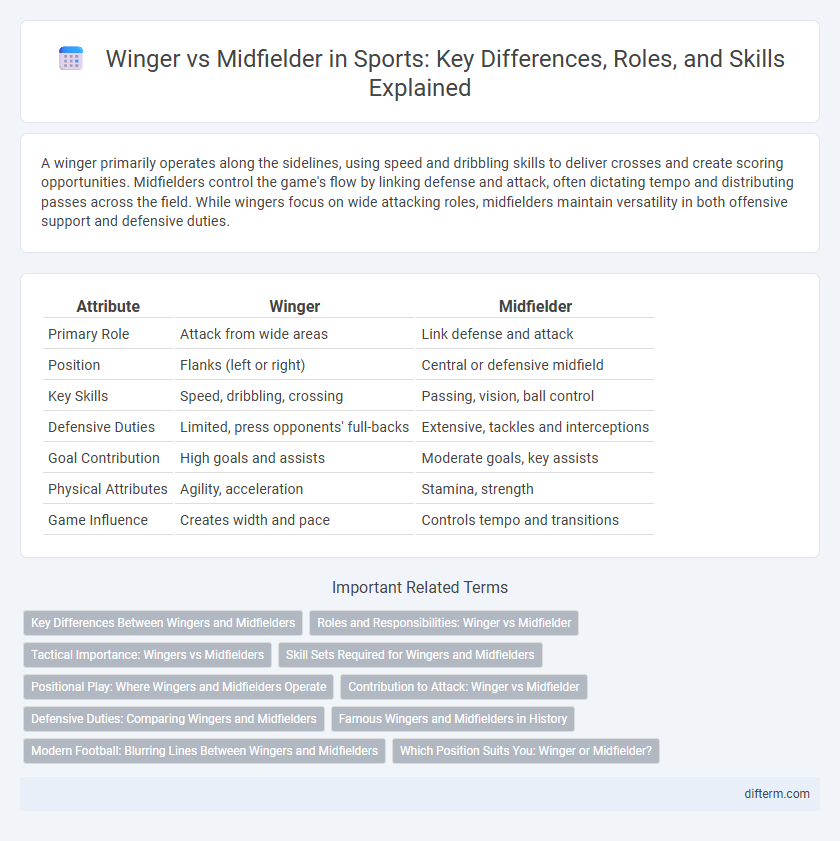A winger primarily operates along the sidelines, using speed and dribbling skills to deliver crosses and create scoring opportunities. Midfielders control the game's flow by linking defense and attack, often dictating tempo and distributing passes across the field. While wingers focus on wide attacking roles, midfielders maintain versatility in both offensive support and defensive duties.
Table of Comparison
| Attribute | Winger | Midfielder |
|---|---|---|
| Primary Role | Attack from wide areas | Link defense and attack |
| Position | Flanks (left or right) | Central or defensive midfield |
| Key Skills | Speed, dribbling, crossing | Passing, vision, ball control |
| Defensive Duties | Limited, press opponents' full-backs | Extensive, tackles and interceptions |
| Goal Contribution | High goals and assists | Moderate goals, key assists |
| Physical Attributes | Agility, acceleration | Stamina, strength |
| Game Influence | Creates width and pace | Controls tempo and transitions |
Key Differences Between Wingers and Midfielders
Wingers primarily operate along the flanks, utilizing speed and dribbling skills to deliver crosses and create goal-scoring opportunities, whereas midfielders control the game's tempo through passing accuracy and spatial awareness in central areas. Wingers tend to have a more offensive role, focusing on beating defenders and providing assists, while midfielders balance defensive duties with orchestrating attacks. The distinction lies in positioning and responsibilities: wingers stretch the defense wide, and midfielders maintain possession and distribute the ball strategically.
Roles and Responsibilities: Winger vs Midfielder
Wingers primarily focus on attacking duties by delivering crosses, creating scoring opportunities, and using pace to exploit the flanks, while midfielders maintain possession, distribute the ball, and support both defense and attack through precise passing and tactical awareness. Midfielders often control the tempo of the game, intercept opposition plays, and provide defensive cover, whereas wingers prioritize width and stretching the opponent's defense. The balance between creative playmaking and defensive responsibility distinguishes midfielders from the specialized attacking role of wingers.
Tactical Importance: Wingers vs Midfielders
Wingers provide tactical width, stretching the opponent's defense with pace and crossing ability, crucial for creating scoring opportunities from wide areas. Midfielders control the game's tempo, linking defense and attack while maintaining possession and distributing passes to exploit gaps. Both positions require distinct spatial awareness and decision-making skills to influence team shape and offensive patterns effectively.
Skill Sets Required for Wingers and Midfielders
Wingers require exceptional pace, dribbling skills, and the ability to deliver precise crosses to exploit wide spaces and create scoring opportunities. Midfielders need superior vision, passing accuracy, and tactical awareness to control the game's tempo and link defense with attack. Both positions demand high stamina and ball control but cater to distinct tactical roles emphasizing width for wingers and central playmaking for midfielders.
Positional Play: Where Wingers and Midfielders Operate
Wingers primarily operate along the flanks, exploiting wide spaces to deliver crosses, cut inside, or stretch the opposing defense. Midfielders function mainly in central or slightly advanced areas, orchestrating play by linking defense and attack while controlling the game's tempo. Their distinct positional roles determine tactical formations and influence ball distribution strategies within a team.
Contribution to Attack: Winger vs Midfielder
Wingers primarily contribute to the attack by delivering crosses, creating width, and making direct runs behind defenses to provide goal-scoring opportunities. Midfielders enhance attacking play through ball distribution, controlling the pace, and linking defense with offense via key passes and through balls. While wingers excel in stretching opposition lines, midfielders offer strategic creativity and support in both offensive buildup and transitions.
Defensive Duties: Comparing Wingers and Midfielders
Wingers primarily focus on attacking threats and wide play but are increasingly tasked with tracking back to support full-backs in defensive phases. Midfielders have more comprehensive defensive responsibilities, including intercepting passes, pressing opponents centrally, and maintaining positional discipline to shield the backline. Tactical systems influence the defensive workload of both roles, but midfielders generally engage more in ball recovery and disrupting opposition build-up.
Famous Wingers and Midfielders in History
Famous wingers like Cristiano Ronaldo and George Best are celebrated for their speed, dribbling, and ability to deliver precise crosses, transforming offensive plays along the sidelines. Legendary midfielders such as Zinedine Zidane and Andres Iniesta excelled in controlling the game's tempo, distributing the ball, and creating scoring opportunities through vision and passing accuracy. Both positions have produced iconic players who shaped football history with distinct skill sets tailored to their tactical roles.
Modern Football: Blurring Lines Between Wingers and Midfielders
Modern football tactics have increasingly blurred the lines between wingers and midfielders, with both roles requiring versatility in attack and defense. Wingers now often drop deep to link play, while midfielders take on wide attacking responsibilities, creating fluid formations and dynamic positioning. This tactical evolution emphasizes spatial awareness, dribbling skills, and passing accuracy as essential attributes for players in both positions.
Which Position Suits You: Winger or Midfielder?
Choosing between winger and midfielder depends on your playing style and physical attributes; wingers require speed, dribbling skills, and the ability to deliver crosses from wide positions, while midfielders need excellent vision, passing accuracy, and stamina to control the game's tempo. A winger suits players who thrive in one-on-one situations and prefer attacking down the flanks, whereas midfielders excel in orchestrating play, supporting both defense and attack in central areas. Understanding your strengths and tactical awareness helps determine whether the dynamic, pace-driven role of winger or the versatile, strategic role of midfielder aligns best with your skills.
winger vs midfielder Infographic

 difterm.com
difterm.com